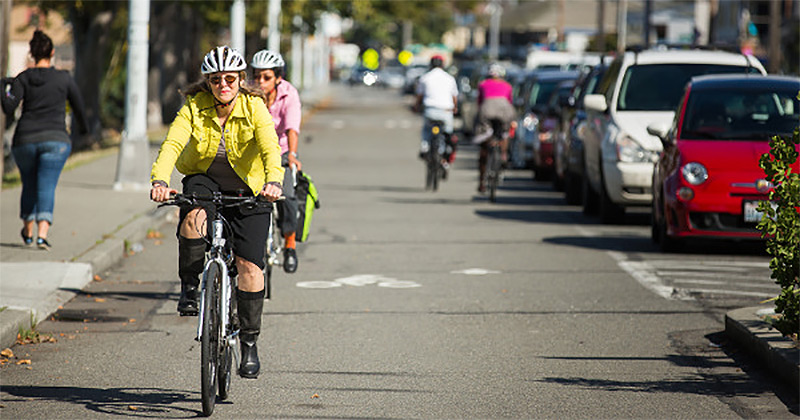We all know that if your goal is to get meaningful numbers of people to ride bicycles, protected bike lanes are better than conventional ones painted into a door zone. But how much better?
Well, adding a bike lane to a four-lane commercial urban street increases the number of American adults who say they’d be “very comfortable” biking on it from 9 percent to 12 percent.
Making that bike lane protected increases the number from 12 percent to 29 percent.
The finding comes from a survey of adults in the 50 largest U.S. metro areas by the National Association of Realtors, conducted by Portland State University and published this summer. It’s some of the clearest, simplest evidence yet that for people of every demographic, a door-zone painted bike lane on a busy street makes far less difference to people’s biking comfort than one with a physical barrier between bike and car traffic.

In fact, the experience of riding in a protected bike lane beats riding in a painted door-zone one by about as much as riding on an off-street path beats riding on a city street at all. That’s true across the board: two genders, every generation, every income, every education level.
(You can read the exact wording of the question here. Participants could choose “very comfortable,” “somewhat comfortable,” “somewhat uncomfortable,” “very uncomfortable” or “don’t know.”)
Obviously there are many streets where cities can’t install protected bike lanes, at least not yet. But if your city’s goal is to increase the number of trips people take on bikes, it shouldn’t be creating door-zone bike lanes unless there’s a clear reason not to do better.
White paint just isn’t good enough to make a major difference.
Looking for statistics that make the case for protected bike lanes? We’ve got a database of them.
[Editor’s Note: This article was cross-posted from People For Bikes.]




One could also add an s to make impact plural in that headline, referring to crashes in and near intersections and driveways.
The one thing that cycletracks–which have been abandoned in all of Europe because they are a major factor in too many cyclist deaths and injuries, and were abandoned in Davis California thirty-plus years ago for the same reasons–do is make cyclists and motorists irrelevant to one-another until moment of impact (or close call).
Thirty-plus years of crash investigation and research (done for, among other agencies, the Motorcycle Safety Foundation) shows that operators of narrow vehicles have better outcomes if they are relevant to other road users. This is why motorcycle drivers are taught to use the left tire track within a given lane.
It’s also worth noting that the causal arrow presumed to be operating in, say, Amsterdam, is quite the reverse of what advocates for fancy painted or bollard-separated infrastructure seem to believe. They have infrastructure BECAUSE they never had less than 15% mode share over the last hundred years. The infrastructure was designed to get the cyclists out of the way of (presumed more legitimate) motor traffic.
Why the current crop of advocates for bad design elements ignores reality is beyond me. I want better outcomes for cyclists, not increased likelihood of crossing-conflict crashes.
Woah, what’s the source of your claim that physically separated bike lanes “have been abandoned in all of Europe”? Pretty sure that’d be news to quite a few cities. One my boss happened to be in recently was Barcelona, which installed this in December.
https://twitter.com/GreenLaneProj/status/604388368361877504
To edit my earlier post: Two way cycletracks, not one-way ones. The one way ones are bad enough–they do an exceptional job of making motorists and cyclists irrelevant to one-another until moment of impact, and the “studies” (using the term loosely) that exemplify confirmation bias in support of them ignore intersection problems or gloss over them or say “imagined problems in intersections can be mitigated,” which means make the whole intersection less useful for all users most of the time. Two-way cycletracks have been proven to be a bad idea, yet American advocates trumpet their wonderfulness with abandon.
http://www.copenhagenize.com/2014/06/explaining-bi-directional-cycle-track.html
I second Tom Armstrong’s comment! As a cyclist in a Midwest city that has installed numerous invisible/ “protected” lanes over the last several years, I find them far too dangerous, to the point where I don’t allow my 10- and 12-year-old boys to use them. I also cannot believe the level of confirmation bias I find in all the studies I come across. It saddens me that we have decided to make conditions for beginning cyclists (Portland State’s “interested but concerned” study cohort) so treacherous, all supposedly in the name of safety.